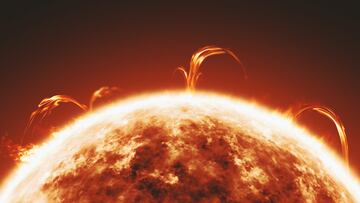NASA warns of two solar flares that could wreak havoc on Earth: here’s all that can happen
The structure of one of the ejections has captured the attention of the scientific community due to its potential for geomagnetic impact.

NASA has issued a serious warning after detecting two powerful solar flares that could have significant consequences for Earth. On May 14, 2025, the Solar Dynamics Observatory recorded an X2.7 solar flare, the highest category on the scale that measures the intensity of these phenomena. This flare, the most powerful of the year to date, has already caused temporary disruptions to high-frequency radio communications in regions of the Middle East.
The solar activity did not stop there. In the following days, NASA instruments identified new sunspots on the Sun’s surface, suggesting that more solar storms could occur in the coming weeks. These flares are associated with coronal mass ejections (CMEs), large clouds of solar plasma that, when interacting with Earth’s magnetic field, can trigger geomagnetic storms capable of disrupting critical infrastructure such as power grids, GPS navigation systems, and communication satellites.
WOW, happening now: an X2.7 flare from AR 4087 rotating in. This is getting intense, especially as this active region turns closer into view. This same AR just produced an M5.3 flare a few hours ago.
— Vincent Ledvina (@Vincent_Ledvina) May 14, 2025
What does this AR have planned over the next days… we’ll have to wait and see. pic.twitter.com/GAgJWi3bJV
One of the most striking aspects of this recent solar activity has been the shape of one of the ejections. This shape indicates a large ejection, with a high probability of interaction with the Earth’s magnetosphere, which has raised concerns among space weather experts.
Impacts on Earth: Communications, Energy, and Navigation at Risk
The consequences of these solar storms can be multiple and far-reaching. NASA has warned that charged particles emitted by the Sun can cause everything from power outages to radio communications failures and errors in satellite navigation systems. High-latitude regions are especially vulnerable to these effects, although the disturbances can be felt globally.
The May 14 phenomenon was accompanied by a coronal mass ejection measuring over 967,000 kilometers in area, more than 75 times the diameter of the Earth. This magnitude was sufficient to disrupt the balance of the Earth’s magnetic field, generating unstable geomagnetic conditions that could persist for several days. Space physicist Tamitha Skov, a space weather expert, explained that the impact of this storm was “grazing,” but strong enough to leave a “very intense wake” that could lead to G2 geomagnetic storm levels.
In addition to the technical effects, these storms can also have visible consequences. The northern and southern lights could be observed at unusual latitudes, a phenomenon that, although visually spectacular, is indicative of a strong disturbance in the Earth’s magnetosphere. Space agencies, including NOAA, are closely monitoring the evolution of these conditions to issue early warnings should they intensify.
Get your game on! Whether you’re into NFL touchdowns, NBA buzzer-beaters, world-class soccer goals, or MLB home runs, our app has it all. Dive into live coverage, expert insights, breaking news, exclusive videos, and more – plus, stay updated on the latest in current affairs and entertainment. Download now for all-access coverage, right at your fingertips – anytime, anywhere.


Complete your personal details to comment
Your opinion will be published with first and last names